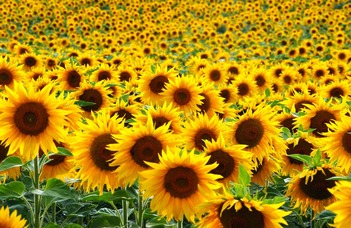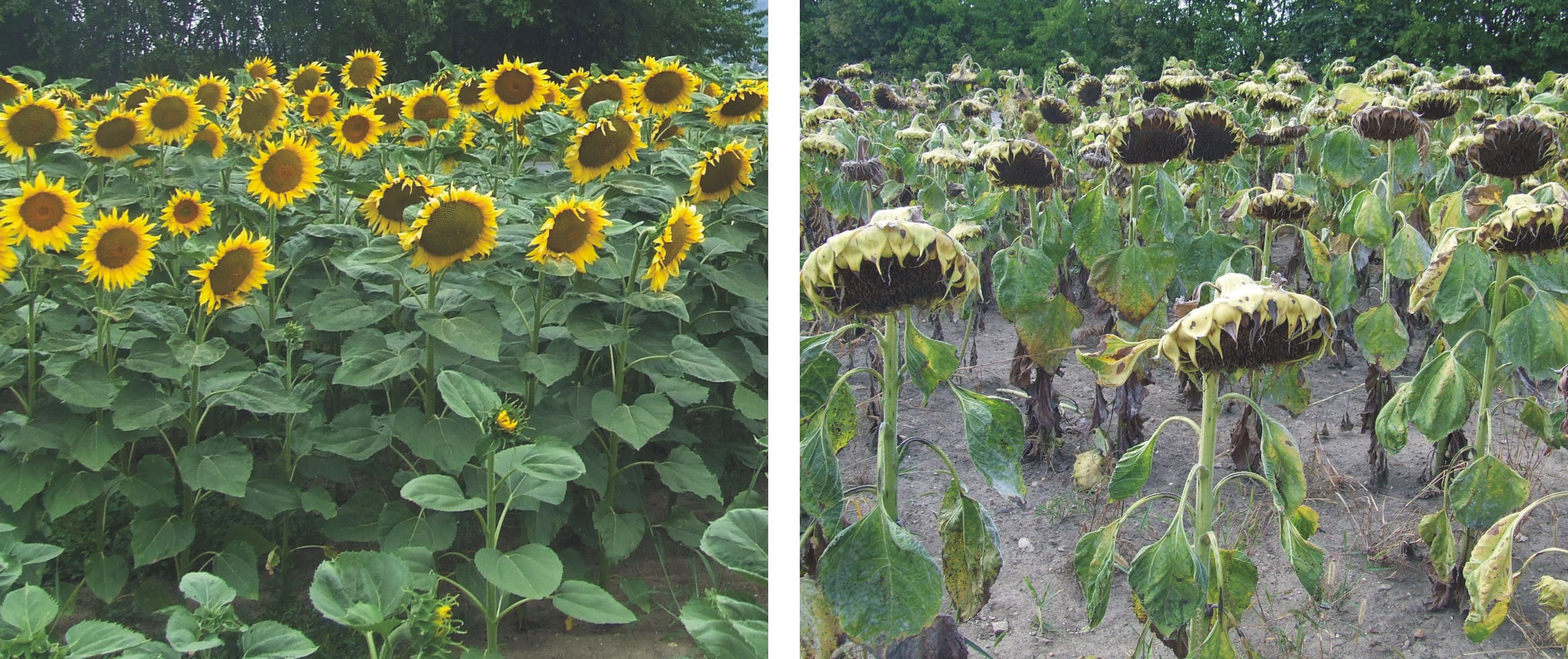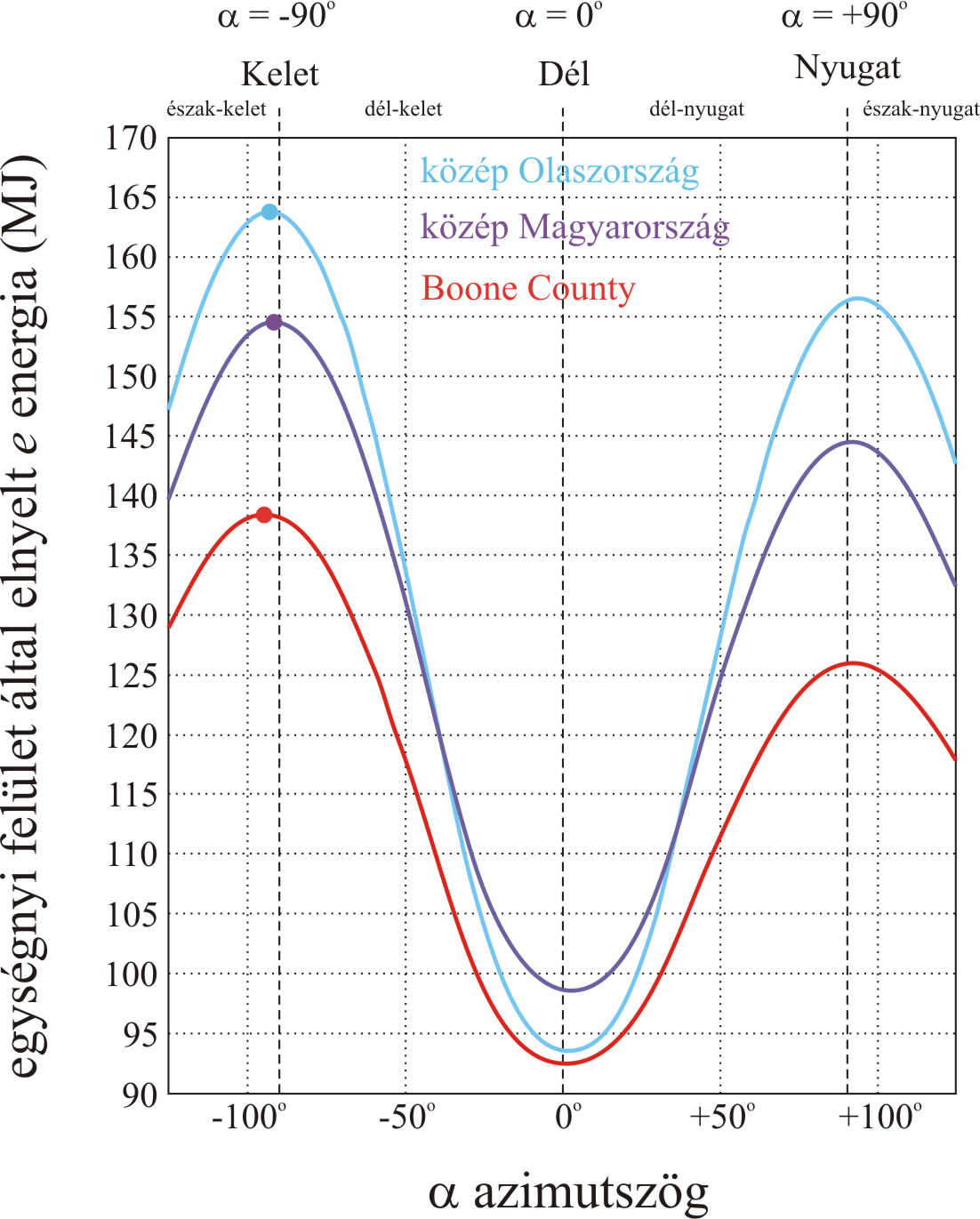Sunflower inflorescences absorb maximum light energy if they face east

The leaves and the immature non-flowering head of common sunflowers (Helianthus annuus) continuously change their orientation so that they always face approximately normal to the incoming solar radiation throughout the day. At sunset, the immature head faces nearly west, while at night it reorients itself and turns nearly east before sunrise. This periodic daily motion is called heliotropism. The orientation of the head and leaves follows the celestial motion of the Sun with a delay of about 12°. On overcast days, the east-west oscillation of the azimuth direction of young sunflower heads stops and the head’s normal vector remains nearly vertical but the older heads oscillate due to an innate biorythm as long as the stem grows.
Besides the domesticated and wild Helianthus annuus sunflowers, some wild relatives also have a daily east to west movement. Many other taxa have similar forms of floral heliotropism, including Chrozophora tinctoria (Euphobiaceae), Xanthium strumarium (Asteraceae), and diverse arctic and alpine species, to mention a few.
In the growing season of sunflowers, the Sun rises exactly in the geographical east and sets exactly in the west only at the spring equinox (21 or 22 March). Before/after the spring equinox, the Sun rises in the southeast/northeast and sets in the southwest/northwest. Therefore, the heliotropic immature sunflower heads face northeast at dawn and northwest at sunset. Sunflower anthesis begins approximately on the 60th day after sowing, when the inflorescence begins to open, immature flowers become visible, the inflorescence is not heliotropic anymore, and usually gets locked facing east/northeast. Leaf expansion also ceases at anthesis, when the sunflower begins investing its resources in seed production in its flowering head. The non-heliotropic mature head contributes 25% of the whole-plant light absorption.

The mature sunflower inflorescences which no longer follow the celestial motion of the Sun (left) and the tilted sunflower heads filled with ripe seeds (right) always face east. (Photos by Gábor Horváth)
After anthesis, the fruiting head bends gradually downwards due to its increasing weight and the heliotropism of sunflower leaves continues with a dampened amplitude. In the literature, the following six hypothetical explanations have been suggested for the ecological functions of the final eastward orientation of the inflorescence of mature sunflower heads:
- Non-skyward eastern orientation may be adaptive, because the narrower perch could reduce seed depredation by birds. This explanation, however, is directionally non-selective and holds true for any azimuth angle.
- The easterly orientation of sunflower inflorescences may have the advantage of reducing the heat load at noon. However, a fixed westerly orientation has the same advantage due to mirror symmetry relative to south.
- The eastward orientation of inflorescences permits greater reception of solar radiation in the early morning, which may speed up drying of morning dew and thus could reduce the opportunity for fungal attack. This idea has not been tested experimentally.
- The east facing of inflorescences may promote sunflower attractiveness to pollinators through increased morning interception of solar radiation, coincident with the daily timing of anther emergence and pollen presentation. A field experiment demonstrated that the surface temperature of sunflower blooms contributes to, but does not solely determine, the differential attractiveness of naturally east-facing and artificially west-oriented flowers to pollinators.
- The eastward orientation of inflorescences could reduce heat load especially during afternoon periods of high irradiance. Keeping cooler floret temperatures may boost yield or fitness by preventing reductions in pollen viability and fertilization or by improving grain filling during seed development and set. However, in afternoons the air temperature, rather than the solar irradiance, is usually higher than in mornings.
- Higher temperatures of sunflower heads result in more rapid seed maturation and reduced grain filling. The surface temperature of east-facing sunflower heads is 3-8 oC lower than that of heads artificially oriented skyward at midday. However, due to symmetry, the same is also true for west-oriented sunflower heads.
Although many physiological details of sunflower heliotropism and nocturnal reorientation have been identified, the ecological functions of the eastward orientation of mature heads are still unresolved.
According to an idea of Gábor Horváth, professor of biological physics (Eötvös University, Department of Biological Physics, Environmental Optics Laboratory, Budapest), one of the reasons for the constant east facing of mature sunflower inflorescences can be that in mornings they receive more direct sunlight than in afternoons, because summer afternoons are usually cloudier than mornings due to stronger convection. Although this hypothesis dates back to his secondary school years, when he frequently visited sunflower plantations near Kiskunhalas (a city in southern Hungary), until now nobody has tested it. Therefore, in 2020 he involved different experts in the test of his hypothesis: Dr. Judit Slíz-Balogh, astronomer (Eötvös University, Department of Astronomy) calculated the trajectories of the Sun in the sky of the North-East-American Boone County, the region from which the domesticated sunflower originates. She also performed these astronomical calculations for Central Italy, Central Hungary, and South Sweden. Imre Jánosi, professor of physics (Eötvös University, Department of Physics of Complex Systems) determined the daily cloudiness of these geographical regions using meteorological data sets. Dr. Ákos Horváth, meteorologist (University of Hamburg, Institute of Meteorology) computed the spectrum of sunlight on the Earth’s surface as a function of the solar elevation angle. Balázs Virágh, BSc student (Eötvös University, Environmental Optics Laboratory), Judit Slíz-Balogh and Gábor Horváth measured the elevation angle of the normal vector of mature sunflower inflorescences as a function of local solar time in the growing season. Dr. Ádám Egri (Ecological Center of the Hungarian Academy of Sciences, Duna Research Institute, Budapest) together with Balázs Virágh measured the absorption spectra of the inflorescence and the back of sunflower heads. Using these astronomical, meteorological and plant-physiological data, Gábor Horváth and Judit Slíz-Balogh computed the total energy of sunlight and diffuse skylight absorbed by the inflorescence and back of mature sunflower heads between the beginning of anthesis (1 July) and the full development of seeds (7 September). Dániel Horváth (Eötvös University, Environmental Optics Laboratory) visualized the results.
They found that if afternoons are cloudier than mornings, then east-facing sunflower inflorescences absorb maximal light energy, furthermore their westward orientation would be more advantageous than a southward orientation. An inflorescence absorbs maximal light energy e at azimuth angle α = ‒94° (Figure 2), which is practically east (αEast = ‒90°). The secondary maximum of the inflorescence’s energy function e(α) is at azimuth α = +92°, practically west (αWeast = +90°). The absolute minimum of e(α) is at azimuth α = +1°, being practically south (αSouth = 0°). An east-facing inflorescence absorbs 1.10 and 1.50 times more light energy than a west- and south-facing one, respectively, while a west-facing inflorescence absorbs 1.36 times more energy than a south-facing one (Figure 2). The photosynthesizing green back of a sunflower head, however, absorbs maximal light energy if the inflorescence faces west. Consequently, the maximization of the energy absorbed by the green back could not explain the eastern orientation of the inflorescence.

Total energy e per unit area absorbed by a mature sunflower inflorescence between anthesis (1 July) and senescence (7 September) as a function of the azimuth angle α of the inflorescence’s normal vector, computed for Boone County, Central Hungary and Central Italy. The primary maxima of the curves are indicated by dots (modified after Figure 5A of [2]).
The 10 to 50% extra light energy absorbed by an east-facing mature sunflower inflorescence compared to a west or south-facing one is advantageous for the development and ripening of the seeds. Furthermore, this surplus energy can accelerate the evaporation of dew condensed at dawn onto the inflorescence, thereby reducing the risk of fungal attack as previously hypothesized. Another advantage of this extra light energy could be that morning-active pollinators may be stronger attracted to the warmer east-facing sunflower inflorescences, as has also been proposed. Thus, the novel environment-optical explanation for the advantage of the east facing of sunflower inflorescences [2] is consistent with some of the earlier hypotheses.
The final conclusion of the Hungarian scientists is that an evident advantage of the east facing of mature sunflower inflorescences is that this azimuth orientation maximizes the light energy absorbed by the inflorescences, if afternoons are cloudier than mornings, as is the case for the origin region of domesticated sunflowers (Boone County), as well as for Central Italy and Central Hungary.

